Beer › Daily Life in the Byzantine Empire » Origins and History
Articles and Definitions › Contents
- Beer › Ancient History
- Daily Life in the Byzantine Empire › Antique Origins
Ancient civilizations › Historical places, and their characters
Beer › Ancient History
Definition and Origins
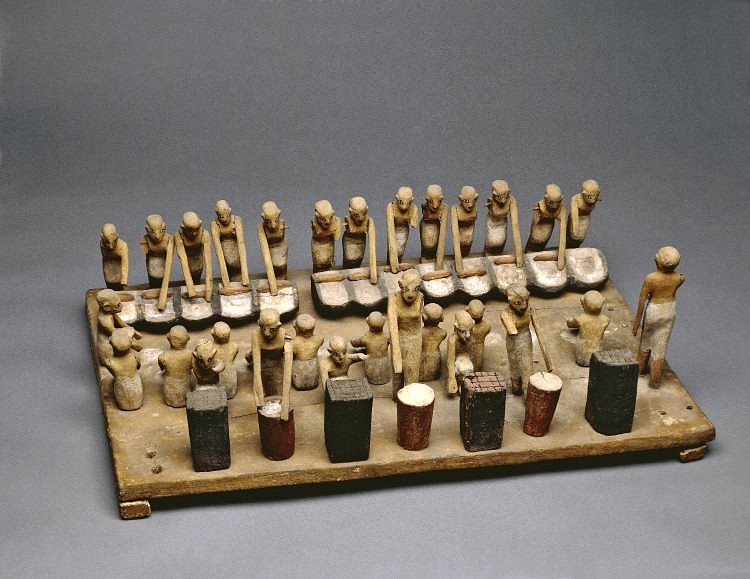
Beer is one of the oldest intoxicating beverages consumed by human beings. Even a cursory survey of history makes clear that, after human beings have taken care of the essential needs of food, shelter, and rudimentary laws for the community, their next immediate concern is developing intoxicants. Evidence of early beer brewing has been confirmed by finds at the Sumerian settlement of Godin Tepe in modern-day Iran going back to between 3500-3100 BCE but intoxicants had already become an integral aspect of daily human life long before. Scholar Jean Bottero writes:
In ancient Mesopotamia, among the oldest `civilized people' in the world, alchoholic beverages were part of the festivities as soon as a simple repast bordered on a feast. Although beer, brewed chiefly from a barley base, remained the `national drink', wine was not uncommon. (84)
Although wine was consumed in Mesopotamia, it never reached the level of popularity that beer maintained for thousands of years. Sumerians loved beer so much they ascribed the creation of it to the gods and beer plays a prominent role in many of the Sumerian myths, among them, Inanna and the God of Wisdom and The Epic of Gilgamesh. The Sumerian Hymn to Ninkasi, written down in 1800 BCE but understood to be much older, is both a praise song to the Sumerian goddess of beer and a recipe for brewing.
MESOPOTAMIAN BEER WAS A THICK, PORRIDGE-LIKE DRINK CONSUMED THROUGH A STRAW & WAS MADE FROM BIPPAR (BARLEY BREAD).
Brewers were female, most likely priestesses of Ninkasi, and early on beer was brewed by women in the home as a supplement to meals. The beer was a thick, porridge-like drink consumed through a straw and was made from bippar (barley bread) which was baked twice and allowed to ferment in a vat. By the year 2050 BCE beer brewing had become commercialized as evidenced by the famous Alulu beer receipt from the city of Ur dated to that time.
THE ORIGIN & DEVELOPMENT OF BEER
It is thought that the craft of brewing beer began in domestic kitchens when grains used for baking bread were left out unattended and began to ferment. Scholars Jeremy Black and Anthony Green, to name only one authority on the subject, write, “alcoholic beverages probably resulted from an accidental discovery during the early hunter-gatherer stage of human prehistory” (Gods,28). While this theory has long been accepted, scholar Stephen Bertman advances another and discusses the long-standing popularity of the drink:
Though bread was basic to the Mesopotamian diet, botanist Jonathan D. Sauer has suggested the making of it may not have been the original incentive for raising barley. Instead, he has argued, the real incentive was beer, first discovered when kernels of barley were found sprouting and fermenting in storage. Whether or not Sauer is right, beer soon became the ancient Mesopotamian's favorite drink. As a Sumerian proverb has it: "He who does not know beer, does not know good." The Babylonians had some 70 varieties, and beer was enjoyed by both gods and humans who, as art shows, drank it from long straws to avoid the barley hulls that tended to float to the surface. (292)

Lapis Lazuli Cylinder Seal of Queen Puabi
The scholar Max Nelson also rejects the claim that brewing beer was discovered accidentally, writing :
Fruits often naturally ferment through the actions of wild yeast and the resultant alcoholic mixtures are often sought out and enjoyed by animals. Pre-agricultural humans in various areas from the Neolithic period on surely similarly sought out such fermenting fruits and probably even collected wild fruits in the hopes that they would have an interesting physical effect (that is, be intoxicating) if left in the open air. (9)
Beer became popular, not only because of the taste and its effects, but because it was healthier to drink than the water of the region. Scholar Paul Kriwaczek details how the waste disposal systems of the cities of Mesopotamia were intricately designed to deposit human and animal waste outside the city walls, and yet that was precisely where the water supply was usually located. Kriwaczek notes how this was "a magnificent engineering achievement but a potential disaster for public health" (83).The best waters were far from the cities but nearby streams could be tapped for water to make beer which was safer to drink because of the fermenting process which involved boiling the water. Kriwaczek continues:
If the watercourses were unsafe, boreholes and wells were no more providers of drinking water, as the saline water-table was too close to the surface. Beer therefore, sterilized by its weak alcohol content, was the safest drink, just as in the western world, as late as Victorian times, it was served at every meal, even in hospitals and orphanages. In ancient Sumer, beer also constituted a proportion of the wages paid to those who had to serve others for their living. (83)
Beer became the drink of choice throughout the region and especially so once it developed into a commercial enterprise. At this point, it seems, the business was taken over by men who recognized how lucrative it could be and women - the traditional brewers - continued on under their supervision. The brew was all hand-crafted, of course, but as it gained in popularity was made in greater quantities and this led to the development of larger-scale breweries. Scholar Gwendolyn Leick comments:
Beer was produced mainly from barley. From the pounded grain, cakes were molded and baked for a short time.These were pounded again, mixed with water, and brought to fermentation. Then the pulp was filtered and the beer stored in large jars. Mesopotamian beer could be kept only for a short time and had to be consumed fresh.The cuneiform texts mention different kinds of beer, such as "strong beer", "fine beer", and "dark beer". Other sorts were produced from emmer or sesame, as well as dates in the Neo-Babylonian Period and later. (33)
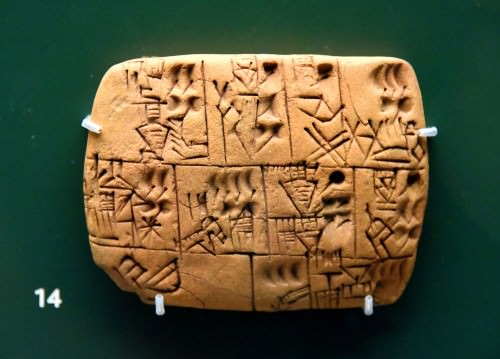
Mesopotamian Beer Rations Tablet
The gods were thought to have given beer to humanity and so beer was offered back to them in sacrifice at the temples throughout Mesopotamia. As noted, it was also used to pay wages and was consumed readily at religious festivals, celebrations, and funeral ceremonies. Beer was associated with good times as a drink which made one's heart feel light and allowed one to forget one's problems.
In The Epic of Gilgamesh, for example, the hero, distraught over the death of his friend, sets out on a quest for immortality and the meaning of life. In his travels, he meets the barmaid Siduri who suggests he leave off such lofty aspirations and simply enjoy life while he lives; in short, she tells him to relax and have a beer. Beer was widely enjoyed for a variety of reasons and under virtually every sort of circumstance. Black and Green write:
That commercialized social drinking, not for religious or medicinal purposes, was common by at least the early second millennium BC is attested by the laws of Hammurabi of Babylon regulating public houses. (Gods, 28)
Although the Sumerians had first developed the craft of brewing, the Babylonians took the process further and regulated how it was brewed, served, and even who could sell it. A priestess who had been consecrated to a deity, for example, was allowed to drink as much beer as she pleased privately but was prohibited from opening a tavern, serving beer, or entering a tavern to drink publicly like a common woman.
HAMMURABI'S CODE THREATENS DEATH BY DROWNING FOR ANY WOMAN TENDING BAR WHO POURS A `SHORT MEASURE' OF BEER FOR A CUSTOMER.
As with the brewing process itself, the first bartenders were women as the Code of Hammurabi makes clear. Among other regulations, Hammurabi's code threatens death by drowning for any woman tending bar who pours a `short measure' of beer for a customer; meaning anyone who does not fill the customer's vessel in accordance with the price paid.
BEER TRAVELS THE WORLD
Through trade, beer travelled to Egypt where the people embraced the brew eagerly. Egyptians loved their beer as much as the Mesopotamians did and breweries grew up all around Egypt. As in Mesopotamia, women were the first brewers and beer was closely associated with the goddess Hathor at Dendera at an early stage. Scholar Richard H. Wilkinson writes:
Hathor was associated with alcoholic beverages which seem to have been used extensively in her festivals, and the image of the goddess is often found on vessels made to contain wine and beer. Hathor was thus known as the mistress of drunkenness, of song, and of myrrh, and it is certainly likely that these qualities increased the goddess's popularity from Old Kingdom times and ensured her persistence throughout the rest of Egypt's history. (143)
Although Hathor encouraged people to freely express their joy in life through drink, it should be noted that drinking to excess was only appropriate under certain conditions. Neither Hathor nor any of the other Egyptian deities smiled upon drunk workers or those who abused alcohol to another's detriment. The universal principle of ma'at (harmony and balance) allowed for excessive drinking but always in balance with the rest of one's daily responsibilities, one's family, and the larger community.
Hathor was not the primary goddess of beer, however; the Egyptian goddess of beer was Tenenit (from one of the Egyptian words for beer, tenemu ) and it was thought the art of brewing was first taught to her by the great god Osiris himself. Like Ninkasi in Sumer, Tenenit brewed her beer from the finest ingredients and oversaw every aspect of its creation.
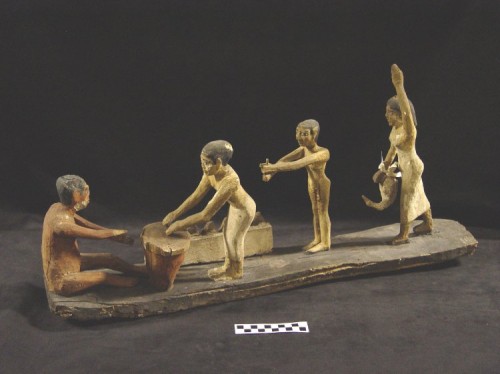
Beer Brewing in Ancient Egypt
The final result of her efforts was a brew which was enjoyed throughout the land in a number of different varieties. Workers at the Giza plateau received beer rations three times a day and prescriptions for various ailments included the use of beer (over 100 recipes for medicines included the drink). As in Mesopotamia, beer was thought to be healthier than drinking water and was consumed by Egyptians of all ages, the youngest to the oldest.
From Egypt, beer traveled to Greece (as evidenced by the similarity of another of the Egyptian's word for beer, zytum and the ancient Greek for the beverage, zythos ). The Greeks, however, as the Romans after them, favored strong wine over beer and considered the grainy brew an inferior drink of barbarians. The Roman Emperor Julian even composed a poem extolling the virtues of wine as a nectar while noting that beer smelled like a goat. That the Romans did brew beer, however, is evidenced by finds at the Roman outpost in Regensburg, Germany - founded in 179 CE by Marcus Aurelius as Casta Regina- as well as at Trier and other sites.
THE FALL & RISE OF BEER
As the Roman Empire spread, so naturally did Roman culture and tastes. Since the Romans favored wine over beer, beer was considered a distasteful “barbarian beverage” as compared with the cultivated and higher-class drink of wine. Even so, it seems it was primarily the Celts who were first responsible for wine's preferential status over beer as they also considered beer an unfit drink for a man. Nelson writes:
Beer was thought to be an inferior type of intoxicant since it was (at least often) affected by the corrupting power of yeast and was naturally a `cold' and hence effeminate substance while wine was thought to be unaffected by yeast and to be rather a `hot' and hence manly substance. (115-116)
The Gauls were “addicted to the wine imported by Italian merchants which they drank unmixed [with water] and in immoderate amounts to the point of falling into stupors” and also that they were so enamored of wine that they would “exchange a slave for one jar of Italian wine” (Nelson, 48-49). However poorly beer was viewed by the prevailing elite, though, their attitude did nothing to stop people from brewing the drink.

Urartian Beer Pitchers
As Nelson makes clear throughout his work, The Barbarian's Beverage: A History of Beer in Ancient Europe, the brew recognized in the modern day as `beer' developed in Germany and their brewing techniques then influenced further development throughout Europe. The Germans were brewing beer as early as 800 BCE and their early methods mirrored those of the ancient Sumerians in regard to purity of the brew but with the important addition of hops. Women were also the first brewers in Germany and beer was made from only fresh water, heated, and the best grains. The tradition continued down into the Christian era when monks took up the craft of brewing and sold beer from their monasteries.
Beer was still considered a divine gift, now given by the Christian god, and the evils which might arise from drunkenness was ascribed to the devil (Nelson, 87). The biblical injunction to refrain from drunkenness (Ephesians 5:18) was not thought to apply to the drink itself but rather to overindulgence which opened the door for darker powers to enter one's life rather than one being filled with the Holy Spirit sent from God. This view of beer is similar to that of the people of ancient Mesopotamia who blamed an individual for over-indulgence in drink, and the attendant problems which might arise, but never the drink itself.
By 770 CE, the Christian champion Charlemagne the Great was appointing brewers in France and, like the Babylonians before him, regulated the production, sale, and use of it. Beer was still understood to be healthier to drink than water because of the brewing process and continued to be associated with a divine origin; its popularity also continued undiminished. The Finnish epic, The Kalevala (written in the 17th century CE, but based on much older tales) devotes more lines to beer than to the creation of the world and praises the effects of beer in such a way that they would easily be recognizable to anyone from ancient Sumeria to a modern-day drinker.
Brewers continued to enjoy a special status in their communities until the 19th and 20th centuries CE when temperance groups gained political power in the United States and areas of Europe and were able to effect prohibition to greater or lesser degrees. Even so, the long-established popularity of intoxicants among human beings could not be suppressed by legislation and all the acts of all the governing bodies would not stop brewers and vintners from rising again. In the modern day, beer is as lucrative a commercial venture as it was in the ancient world and the drink retains its popularity on an international scale.Whether an individual is experiencing good or bad times, beer continues to enjoy the same high status it did in ancient Mesopotamia: the drink which makes one's heart feel light.
Daily Life in the Byzantine Empire › Antique Origins
Ancient Civilizations

Man Feeding Mule, Byzantine Mosaic
BIRTH
As in most other ancient cultures, the family one was born into in Byzantium greatly determined one's social status and profession in adult life. There were two broad groups of citizens: the honestiores (the “privileged”) and the humiliores (the “humble”), that is, the rich, privileged, and titled as opposed to everyone else. Legal punishments were more lenient for the honestiores, in most cases being composed of fines rather than corporal punishment. Flogging and mutilation, most commonly having one's nose cut off, were common forms of punishment for such crimes as adultery and the rape of a nun.For crimes such as murder and treason, no social distinction was made with the death penalty for all. Below the two broad groups mentioned above were the slaves who were acquired in markets and through warfare.
LIFE EXPECTANCY WAS LOW BY MODERN STANDARDS, ANYONE WHO GOT PAST 40 YEARS OF AGE WAS DOING BETTER THAN AVERAGE.
Family names became increasingly descriptive of a person's profession or geographical location, for example, Paphlagonitis for people from Paphlagonia or Keroularios the “candle-maker”. Life expectancy was low by modern standards, anyone who got past 40 years of age was doing better than average. Wars occurred roughly once every generation while diseases were rife and ever-present. The primitive medicine was often as dangerous as the illness it sought to cure, too.
CHILDHOOD & EDUCATION
Lower class children essentially learned the profession of their parents. Aristocratic girls learnt to spin, weave, and to read and write. Perhaps they also studied the Bible and lives of saints, but they had no formal education as they were expected to marry and then look after the children, household property, and manage the slaves.
For aristocratic boys, most cities had a school run by the local bishop, but there were also private tutors for those who could afford them. Boys were first taught to read and write in Greek and then schooled in the seven classical arts of antiquity: grammar, rhetoric, logic, arithmetic, geometry, harmonics, and astronomy. Such texts as Homer ’s Iliad and Hesiod ’s Theogony and Works and Days were standard subjects of study and students could memorise whole chunks of them (although to what purpose is not clear other than to impress future dinner guests with weaker memories).
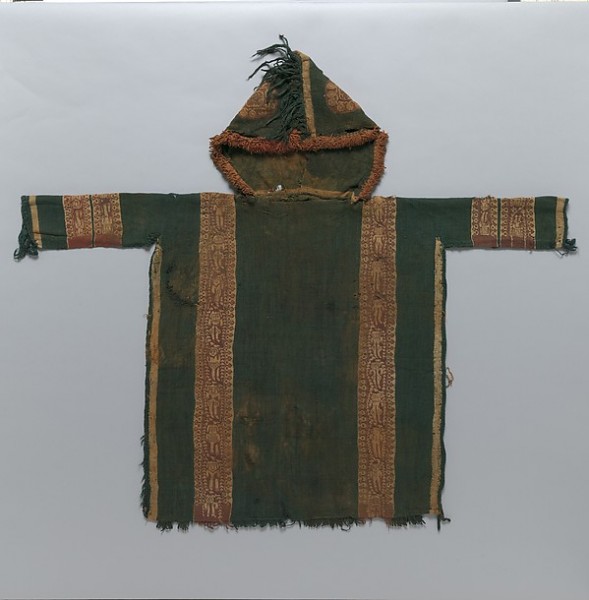
Byzantine Child's Tunic with Hood
Higher education was available in major cities like Constantinople, Alexandria, Athens, and Gaza. The curriculum consisted of the study of philosophy, especially the works of Plato and Aristotle, as well as Christian theology. Children might also be sent for training in either the church or imperial court in the hope of social advancement. Indeed, Constantinople had a specialist school to train young men for the state bureaucracy while there was a famous law school in Berytus. In the 9th century CE, a university was created at the Great Palace of Constantinople where such academic luminaries as Leo the Mathematician taught, and then, in the mid-11th century CE, a new school of law and philosophy was founded at the capital headed by the Patriarch John Xiphilinos (r. 1064-1075 CE).
THE FATHER WAS THE HEAD OF THE FAMILY BUT A WIDOW COULD INHERIT HER HUSBAND'S PROPERTY & SO TAKE OVER THAT ROLE IF NECESSARY.
MARRIAGE & FAMILY
The earliest a girl married was around the age of 12 while for boys it was 14. The involvement and consent of the parents were expected and, consequently, a betrothal was usually regarded as binding. Remarriage was possible as long as a suitable period of mourning was observed by the widow, but a third marriage was rare and only permitted under special circumstances which included being without children. Divorce was difficult to achieve, although if a wife committed adultery she could be put aside and a husband left if he was guilty of murder or witchcraft. The laws of Justinian I (r. 527-565 CE) went even further and prohibited divorce altogether except if both parties consented to retire to a monastic life. The father was the head of the family but a widow could inherit her husband's property and so take over that role if necessary.
FOOD & DRINK
Mealtimes were an important family occasion, of course, and food available to the lower classes and farmers included boiled vegetables, cereals, coarse bread, eggs, cheese, and fruit. Meat and fish would have been a rarity reserved for special occasions. Richer families could afford such meat as wild birds, hares, pork, and lamb more often. Olive oil was a common condiment, many spices came from the east, and wine was widely available. Some known desserts are vine leaves or pastry stuffed with currants, nuts, cinnamon, and honey. People mostly ate with their fingers or perhaps a knife, but the two-pronged fork, used by the ancient Romans and then forgotten, did make a comeback amongst the aristocracy of Byzantium.

Herdsman Milking a Goat, Byzantine Mosaic
JOBS & WORK
At the top of the Byzantine career ladder were the 'white-collar' workers who had acquired specific knowledge through education such as lawyers, accountants, scribes, minor officials and diplomats, all of whom were essential to the efficient running of the state. Then there were traders, merchants, and even bankers who might have been extremely rich, but they were held in low esteem by the aristocracy and viewed with some suspicion. Craftsmen and food producers (men and women) were less socially mobile as members of the major guilds ( collegia ) were expected to remain in their professions and pass on their skills to their children. This was especially so for vintners, ship-owners, bakers, and pork producers. Women did many jobs that men did but often provided specialised services as midwives, medical practitioners, washerwomen, cooks, matchmakers, actresses and, of course, as prostitutes. Women could own their own businesses if they had the means.
Although converting ancient currency to modern ones can be misleading, it is interesting to compare the value of one profession's work with another as seen in these values mentioned in Diocletian ’s monetary reforms of the early 4th century CE, which give an idea of labour costs in the early Byzantine Empire :
- 25 denarii for one day's wages for a labourer
- 50 denarii for one day's wages for a baker
- 150 denarii for one day's wages for a painter.
The largest population group was the small-scale farmers who owned their own land and the most humble citizens of all who worked as agricultural labourers ( coloni ) on the large estates of the aristocratic landowners ( dynatoi ). This labourers were not very much higher or treated better than slaves who were the lowest of the low.
HOUSING
The well-off had large multi-roomed houses with inner courtyards, bathrooms, gardens, fountains, and even a small chapel.The public rooms of such houses had marble floors and walls decorated with mosaics while those private rooms such as bedrooms, which were usually on the second floor, had painted interiors. Grander houses even had a segregated part of the home reserved only for the women of the household, the gynaikonitis, but this seems to have been a private space to keep men out rather than a restricted place from which women could not leave.
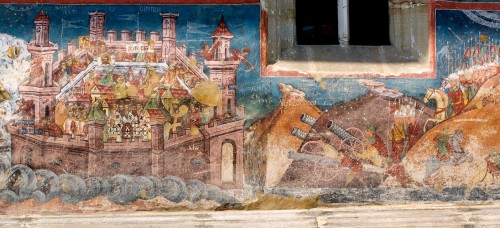
The Siege of Constantinople
Most ordinary folks' houses were built using bricks and stones, often from older damaged buildings. To give a smarter appearance, exterior walls were covered in plaster and often incised with regular lines to make them look like they were made from regular stone blocks. Even more common was to paint the walls in bright colours, sometimes with bold geometric patterns. These types of homes had only rudimentary sanitation, and we know that laws forbade city residents from emptying their chamber pots out of the window and into the street.
RURAL HOUSES HAD NO RUNNING WATER & THERE IS NO EVIDENCE OF INTERIOR BATHROOMS.
Many poorer citizens would have lived in the simple multistorey buildings the western Romans had created, the insulae. Still more lived on the outskirts of town in ramshackle buildings of wood, mud bricks, and reused rubble. In rural areas, a small group of houses might be built to form a village. Buildings here had two stories - the lower for animals and the upper for the farmers - and an inner courtyard overlooked by a verandah. Rural houses had no running water, and there is no evidence of interior bathrooms. Perhaps surprisingly, these country houses were often built of dressed stone with well-carved frames and niches.
There were no planning rules, and the various designs and materials used in buildings meant that the towns presented an eclectic urban landscape with a maze of small haphazard streets. Outside the town or city were such communal places as those for washing clothes, the rubbish dump, and an execution ground.
CLOTHING
The aristocracy wore fine clothes, including silk, which was first imported from China and Phoenicia and then produced in Constantinople from 568 CE. Nobles could wear clothes dyed with Tyrian purple, which set them apart from commoners because it was tremendously expensive to produce and they were banned from wearing it anyway. The rich Byzantines also liked a bit of gold, silver, and gemstone-studded jewellery, too. Aristocrats were not entirely free from fashion rules, though, as Emperor Justinian I (r. 527-565 CE) decreed that nobody except himself could embellish their belt or their horse's bridle and saddle with pearls, emeralds or hyacinths.
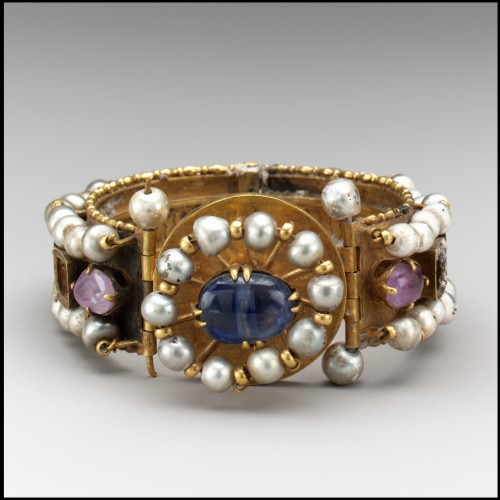
Byzantine Jeweled Bracelet
Certain high-ranking officials even had their own distinct clothes of office. The colour of a cloak, tunic, belt, and shoes, or the particular design and material of a fibula could indicate visually the wearer's office. Indeed, some of the buckles worn were so precious and the risk of theft so high that many officials wore imitations made from gilded bronze. Poorer members of society had to make do with less splendid attire with the woollen short tunic and long cloak dominating wardrobes, trousers not being introduced to Byzantium until the 12th century CE.
LEISURE
Getting out and about in a Byzantine town was an entertainment in itself, much like any modern metropolis today, as the streets were filled with jugglers, acrobats, beggars, food and drink vendors, idlers, prostitutes, fortune tellers, lunatics, holy men ascetics and preachers. Citizens could shop in markets which were held in dedicated squares or in the rows of permanent shops which lined the streets of larger towns and cities. Shoppers were protected from the sun and rain in such streets by collonaded roofed walkways, which were often paved with marble slabs and mosaics. Some shopping streets were pedestrianised and blocked to wheeled traffic by large steps at either end.
Apart from a wide range of meat, seafood, fruit and vegetables, the Byzantine shopper with money in their purse might be tempted by spices, perfumes, incense, soap, medicines, textiles (eg silk, wool, linen, and fur), jewellery, pottery, glassware, brass wares, silver plates, small art objects carved from wood or ivory, and even slaves.

Byzantine Ivory Casket
Goods in markets were scrupulously weighed out using official standardised weights and measures. Prices, too, were regularly checked by state inspectors to ensure there was no unnecessary profiteering. Especially good moments to go shopping were during the many festivals and fairs held on such important religious dates as saint's birthdays or death anniversaries. Then churches, especially those with holy relics to attract pilgrim visitors from far and wide, became the centrepiece of temporary markets where stalls sold all manner of goods. One of the largest such fairs was at Ephesus, held on the anniversary of Saint John's death.
For an even more thrilling pastime than strolling about there was the Hippodrome of Constantinople, and many others like it across the empire, where chariot races were held (although most venues would have been simple tracks without the seating).The intermission was worth waiting for, too, when musicians, acrobats, and animal trainers amused the crowd. Betting on the races and supporting particular teams as part of the crowd factions or supporter groups added much spice to the proceedings.Public arenas offered more than just sports, though, with festivals, commemorative events, public executions and punishments, and military triumphs with their glittering war booty and exotic prisoners, all being held there throughout the year.
In smaller towns, the theatre served a similar purpose, as well as being a place of public meetings which not infrequently developed into a riot that spread through the town in protest of local government policies or high taxes. Another sporting venue was the stadium where athletic contests were staged. Finally, there were plenty of places where both men and women could just hang around, meet up and chat over the issues of the day such as the public baths, the local gymnasia or even church.
DEATH
The dead were commonly buried in dedicated cemeteries located outside the town proper. Different classes ranging from public officials to actresses had epitaphs carved in stone above their graves and illustrate that commemorating the dead was not a practice limited to the rich. Further, these epitaphs are a valuable source of information regarding Byzantine daily life, revealing such details as names, professions and attitudes to life in general.
LICENSE:
Article based on information obtained from these sources:with permission from the Website Ancient History Encyclopedia
Content is available under License Creative Commons: Attribution-NonCommercial-ShareAlike 3.0 Unported. CC-BY-NC-SA License